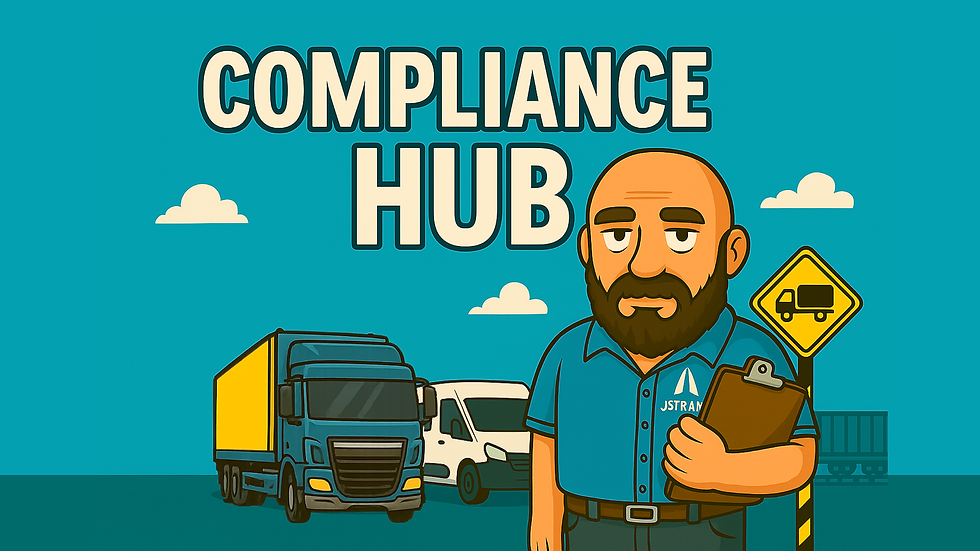

3. Driver Management & Compliance
Ensuring your drivers are safe, legal, and operating to the highest standards
Proper driver management is at the heart of staying compliant with your Operator’s Licence obligations. Whether you’re a sole trader with one vehicle or running a small fleet, keeping on top of driver responsibilities and legal requirements is essential—not just to protect your licence, but also to safeguard your business reputation and road safety record.
This guide breaks down the key areas of driver management and compliance, with links to practical resources, blog articles, and downloadable templates to help you put systems in place.
Why Driver Compliance Matters
Restricted licence holders are still fully responsible for ensuring drivers:
-
Hold the correct licence and training for the vehicles they operate
-
Follow rules on driving hours and working time
-
Maintain high standards of conduct and record-keeping
-
Do not put the Operator Licence at risk through poor performance or negligence
Failure in any of these areas can result in enforcement action, including public inquiry, fines, or the loss of your licence.
Key Responsibilities in Driver Management
1. Driver Licence Checks
You must have systems in place to regularly check that each driver:
-
Holds the correct and valid category of licence
-
Has no disqualifications or endorsements that affect their ability to drive
👉 Read more: How to Set Up a Driver Licence Check Procedure
2. Driver Hours & Working Time Compliance
Even Restricted Licence holders must ensure drivers comply with EU Drivers’ Hours (or GB Domestic Rules) and Working Time Directive limits, where applicable.
-
Maintain up-to-date tachograph records
-
Monitor infringements and address them promptly
-
Use analysis software or a tachograph analysis provider
👉 Read more: Driver Hours Rules Explained
3. Driver Induction & Ongoing Training
New drivers should undergo a proper induction process that covers:
-
Company policies and expectations
-
Health and safety
-
Daily walkaround checks
-
Incident reporting
Ongoing training, including Driver CPC where required, ensures your team stays current and competent.
👉 Read more: Creating a Driver Training Plan for Small Fleets.
4. Daily Walkaround Checks
Every driver must perform a walkaround check before using a vehicle. You must:
-
Keep a documented defect reporting system
-
Investigate and repair any reported issues promptly
-
Retain records for at least 15 months
👉 Read more: Walkaround Check Best Practice Guide.
👉 Download: Defect Report Sheet Template (Editable). (Post Coming Soon)
5. Driver Behaviour, Conduct & Disciplinary Procedures
It’s vital to manage driver behaviour on and off the road:
-
Set clear policies for speeding, mobile phone use, and fatigue
-
Record and address complaints or incidents
-
Use formal warnings and structured disciplinary procedures where needed
👉 Read more: Managing Driver Conduct: A Compliance-First Approach.
6. Record Keeping & Audit Trail
VOSA and DVSA expect Restricted Licence holders to retain proper records. You should:
-
Keep logs of licence checks, training, hours, infringements, defect reports
-
Review these records periodically as part of internal audits
-
Be prepared to show them at short notice
👉 Blog: Building a Driver Compliance File: What to Include.
Tools & Downloads
We’ve created free tools to help streamline your driver management process:
✅ Driver Licence Check Log Template
✅ Tachograph Infringement Monitoring Sheet
✅ Driver Induction Checklist
✅ Walkaround Defect Report Pad (Printable)
✅ Driver Compliance File Structure Guide
👉 Browse our Free Compliance Tools Library. (Post Coming Soon)
Related Blogs
To help you dive deeper into specific areas, explore these grouped content clusters:
📌 Driver Hours & Tachograph Use
EU vs GB Domestic Rules: What Applies to You?
How to Read and Interpret Tachograph Data
Using Tachograph Analysis Services: Pros & Cons
📌 Recruitment & Training
Checklist for Hiring Your First Driver
Mandatory Training vs Best Practice Training
How to Plan Driver CPC with Minimal Disruption
📌 Compliance Systems for Small Operators
How to Keep a Simple but Effective Driver Log
Digital vs Paper Record-Keeping: What Works Best?
Compliance Monitoring: Setting Reminders That Work
Final Thoughts
Driver compliance isn’t just a tick-box exercise—it’s a foundation for operating safely, efficiently, and within the law. With the right systems in place, you can stay ahead of problems and run a professional operation that the Traffic Commissioner would be proud of.
Want tailored advice for your fleet or situation?
👉 Contact JS Transport Solutions for a 1-to-1 Compliance Review

